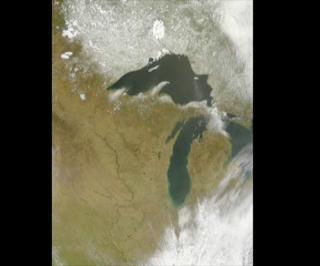Dust Storms of Asia
A series of dust clouds originating with distinct wind events over Asia two weeks ago, have made their way across the Pacific and spread a whitish haze across half of the U.S., sources say.
Gene Feldman, a scientist at NASA's Goddard Space Flight Center in Greenbelt, MD said aircraft have been monitoring the particulates in the dust clouds. Apparently, the dust clouds picked up industrial pollution from two of China's largest cities and are now blanketing the mid-Western United States with this matter. Dr. Feldman said, "At one time, the dust cloud was bigger than Japan."
As early as 1998, scientists were claiming that industrial pollution from China was spreading to the United States where pollution in the U.S. was rising to two-thirds the federal health limits. The current storm proves this theory to be true. Pollution from Asia is reaching in the U.S. in alarming amounts.
The particulates in the dust clouds that reduce visibility and cause respiratory problems have not been measured in such high volume since Mt. St. Helens erupted, and even then, the particulates did not reach the ground as they are in this case.
The dust storms could even reach the Eastern U.S., but experts say they will probably dissipate as they move across the midwest.
Dust storms in Asia, catches a ride with the
gulf stream and heads towards the United States.

Asias dust storms catches a ride with the
gulf stream and heads towards the United States.

Asias dust storms rides high on the gulf stream and heads towards the United States.

Video slate image reads, "Asia dust storm
This storm will travel to the U.S. via the Gulf Stream."
Credits
Please give credit for this item to:
NASA/Goddard Space Flight Center, The SeaWiFS Project and GeoEye, Scientific Visualization Studio. NOTE: All SeaWiFS images and data presented on this web site are for research and educational use only. All commercial use of SeaWiFS data must be coordinated with GeoEye (NOTE: In January 2013, DigitalGlobe and GeoEye combined to become DigitalGlobe).
-
Animator
- Stuart A. Snodgrass (Global Science and Technology, Inc.)
-
Scientist
- Gene Feldman (NASA/GSFC)
Release date
This page was originally published on Wednesday, April 18, 2001.
This page was last updated on Wednesday, May 3, 2023 at 1:58 PM EDT.
Datasets used
-
[SeaStar: SeaWiFS]
ID: 100NOTE: All SeaWiFS images and data presented on this web site are for research and educational use only. All commercial use of SeaWiFS data must be coordinated with GeoEye
Credit: NASA/Goddard Space Flight Center, The SeaWiFS Project and GeoEye, Scientific Visualization Studio. NOTE: All SeaWiFS images and data presented on this web site are for research and educational use only. All commercial use of SeaWiFS data must be coordinated with GeoEye (NOTE: In January 2013, DigitalGlobe and GeoEye combined to become one DigitalGlobe.).
See all pages that use this dataset
Note: While we identify the data sets used on this page, we do not store any further details, nor the data sets themselves on our site.
